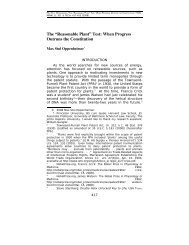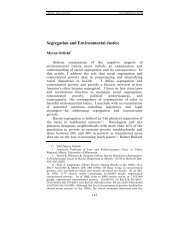An Organizational Approach to the Design of Patent Law
An Organizational Approach to the Design of Patent Law
An Organizational Approach to the Design of Patent Law
Create successful ePaper yourself
Turn your PDF publications into a flip-book with our unique Google optimized e-Paper software.
6 VERTINSKY FINAL_JAD (DO NOT DELETE) 2/27/2012 2:20 PM<br />
2012] AN ORGANIZATIONAL APPROACH 219<br />
ment in<strong>to</strong> <strong>the</strong> design <strong>of</strong> reform strategies. 24 It can be used <strong>to</strong><br />
evaluate divergent opinions on what <strong>the</strong> process <strong>of</strong> change<br />
should look like, in particular whe<strong>the</strong>r courts, legisla<strong>to</strong>rs, or a<br />
USPTO with expanded lawmaking authority should take a<br />
leading role in changing <strong>the</strong> direction <strong>of</strong> patent law. 25<br />
Part I <strong>of</strong> this Article explores <strong>the</strong> limits <strong>of</strong> <strong>the</strong> traditional<br />
law and economics approach <strong>to</strong> patent law and <strong>the</strong> implications<br />
<strong>of</strong> <strong>the</strong>se limits for current patent policy design. Part II provides<br />
a brief background on NIE and explains how <strong>the</strong> <strong>to</strong>ols and<br />
methodologies <strong>of</strong> NIE can be used <strong>to</strong> address <strong>the</strong> limitations <strong>of</strong><br />
traditional patent law approaches <strong>to</strong> innovation and patent reform.<br />
26 Part III describes <strong>the</strong> proposed organizational approach<br />
<strong>to</strong> patent law, outlining <strong>the</strong> methodology and providing a<br />
framework <strong>to</strong> guide its application <strong>to</strong> <strong>the</strong> strategic design <strong>of</strong> patent<br />
law. Under <strong>the</strong> organizational approach <strong>the</strong> focal points <strong>of</strong><br />
patent policy design become developing patent laws that are:<br />
(1) responsive <strong>to</strong> <strong>the</strong> needs <strong>of</strong> alternative innovation processes<br />
and <strong>the</strong> different motivations <strong>of</strong> entrepreneurs; (2) designed <strong>to</strong><br />
reduce <strong>the</strong> propensity for behaviors which are most costly <strong>to</strong><br />
<strong>the</strong> organization <strong>of</strong> economic activities (i.e. those behaviors involving<br />
defection from agreed upon norms or rules <strong>of</strong> behavior);<br />
and (3) robust <strong>to</strong> constraints on rule design and implementation<br />
and sensitive <strong>to</strong> alternative mechanisms for regulating behavior.<br />
Part IV illustrates how <strong>the</strong> organizational approach can<br />
be used <strong>to</strong> inform <strong>the</strong> design <strong>of</strong> patent law in response <strong>to</strong> contemporary<br />
challenges facing <strong>the</strong> current patent system. This<br />
Article concludes that adopting an organizational approach <strong>to</strong><br />
24. Some reform proposals focus solely on <strong>the</strong> administration <strong>of</strong> patent<br />
law ra<strong>the</strong>r than <strong>the</strong> substance <strong>of</strong> <strong>the</strong> rules; <strong>the</strong>y examine <strong>the</strong> comparative<br />
strengths and limits <strong>of</strong> alternative rule making processes. See e.g,. Michael J.<br />
Burstein, Rules for <strong>Patent</strong>s, 52 WM. & MARY L. REV. 1747, 1758–61 (2011) (examining<br />
<strong>the</strong> problem <strong>of</strong> patent reform as a problem <strong>of</strong> effective administration<br />
and advocating for greater rulemaking authority).<br />
25. See, generally, DAN L. BURK & MARK A. LEMLEY, THE PATENT CRISIS<br />
AND HOW COURTS CAN SOLVE IT 95–108 (2009); Stuart Minor Benjamin & Arti<br />
K. Rai, Fixing Innovation Policy: A Structural Perspective, 77 GEO. WASH. L.<br />
REV. 1, 32–54 (2008).<br />
26. See generally, Douglass C. North, A Recommendation on How <strong>to</strong> Intelligently<br />
<strong>Approach</strong> Emerging Problems in Intellectual Property Systems, 5 REV.<br />
L. & ECON. 1131 (2009) (discussing <strong>the</strong> role <strong>of</strong> NIE in helping <strong>to</strong> develop a<br />
more effective, responsive system <strong>of</strong> regulating innovation). The existing patent<br />
literature includes a number <strong>of</strong> existing applications <strong>of</strong> NIE <strong>to</strong> patent law,<br />
and one benefit <strong>of</strong> <strong>the</strong> organizational approach is its ability <strong>to</strong> integrate <strong>the</strong>se<br />
contributions in a way which yields new insights in<strong>to</strong> how patent policy should<br />
be changed.






